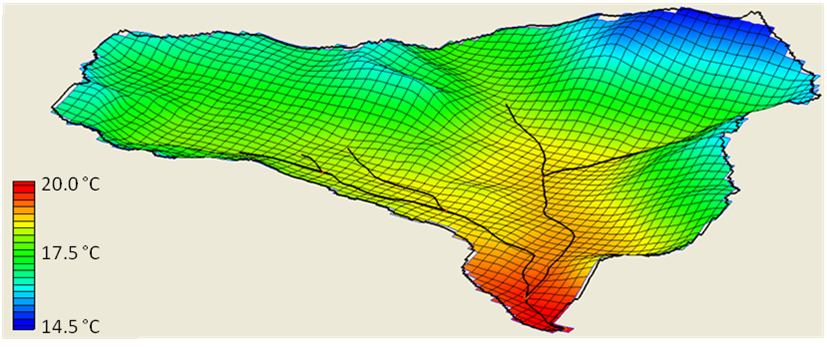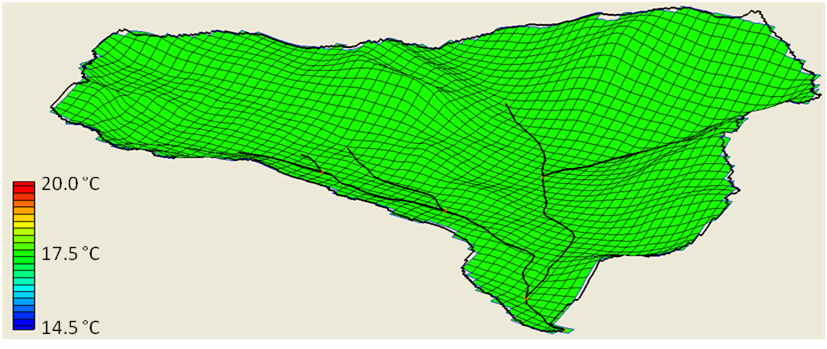Difference between revisions of "Orographic Effects"
| Line 3: | Line 3: | ||
'''GSSHA-Calculated Lapse Rate (Default)''' | '''GSSHA-Calculated Lapse Rate (Default)''' | ||
| − | The GSSHA model uses a derivation of the lapse rate developed by Dr. David Tarboton at the University of Utah to adjust the temperature, pressure, and relative humidity within each cell. Using the hourly hydrometeorological data and known elevation of a gage site as the base, the temperature, atmospheric pressure, vapor pressure, and saturated vapor pressure are calculated at specified elevation intervals until the span of the elevation range within the basin is covered. Elevation intervals are used because once the air becomes saturated condensation occurs, which releases heat and effectively lowers the magnitude of the temperature lapse rate. If the air parcels were uniformly saturated or unsaturated throughout the basin a uniform temperature lapse rate could be used. Because this is not always the case, the elevation intervals are used to help determine when the air becomes saturated, thus altering the temperature lapse rate. | + | The GSSHA model uses a derivation of the lapse rate developed by Dr. David Tarboton at the University of Utah to adjust the temperature, pressure, and relative humidity within each cell. Using the hourly hydrometeorological data and known elevation of a gage site as the base, the temperature, atmospheric pressure, vapor pressure, and saturated vapor pressure are calculated at specified elevation intervals until the span of the elevation range within the basin is covered. Elevation intervals are used because once the air becomes saturated condensation occurs, which releases heat and effectively lowers the magnitude of the temperature lapse rate. If the air parcels were uniformly saturated or unsaturated throughout the basin a uniform temperature lapse rate could be used. Because this is not always the case, the elevation intervals are used to help determine when the air becomes saturated, thus altering the temperature lapse rate.<br> |
<br> | <br> | ||
The only ''Required Card'' is:<br> | The only ''Required Card'' is:<br> | ||
Revision as of 23:22, 28 December 2013
An orographic effect is the natural cooling of air masses as they rise from lower elevations to higher elevations due to terrain. GSSHA currently has two options for accounting for orographic effects. The user is able to define a constant lapse rate when only one temperature gage is located within the basin, and an option where GSSHA calculates the lapse rate hourly based on HMET data and the gage location within the basin. The figures below demonstrates a uniform temperature profile for an entire basin, and a temperature profile that accounts for orographic effects.
GSSHA-Calculated Lapse Rate (Default)
The GSSHA model uses a derivation of the lapse rate developed by Dr. David Tarboton at the University of Utah to adjust the temperature, pressure, and relative humidity within each cell. Using the hourly hydrometeorological data and known elevation of a gage site as the base, the temperature, atmospheric pressure, vapor pressure, and saturated vapor pressure are calculated at specified elevation intervals until the span of the elevation range within the basin is covered. Elevation intervals are used because once the air becomes saturated condensation occurs, which releases heat and effectively lowers the magnitude of the temperature lapse rate. If the air parcels were uniformly saturated or unsaturated throughout the basin a uniform temperature lapse rate could be used. Because this is not always the case, the elevation intervals are used to help determine when the air becomes saturated, thus altering the temperature lapse rate.
The only Required Card is:
HMET_ELEV_GAGE
The Equation below is used to calculate the moist adiabatic lapse rate (θwet) in °C m-1 at the gage site as well as every elevation interval. This is the temperature lapse rate if condensation is occurring. In the model, θwet is assumed to be the lapse rate at the elevation interval whenever the air is saturated (e >= esat), otherwise θdry is assumed to be the lapse rate, which is set at 0.00981 °C m-1.

User-Defined Constant Lapse Rate
The user can define a constant lapse rate (°C m-1), which will be applied to each cell within the basin. The cards required are shown below, followed by the equation used to adjust the temperature within each cell.
Required Cards:
HMET_ELEV_GAGE
YES_DALR_FLAG #.#####
General Method:
|
|
width=550 | Tadj = T + (Elevgage - Elevcell) * LR |
| Tadj = adjusted temperature (°C) |
| Ta = temperature measured at the gage site (°C) |
| Elevcell = elevation of grid cell (m) |
| Elevgage = elevation of gage site (m) |
| LR = lapse rate (°C m-1) |
LR should be positive and between 0.0045 and 0.00981 °C m-1

